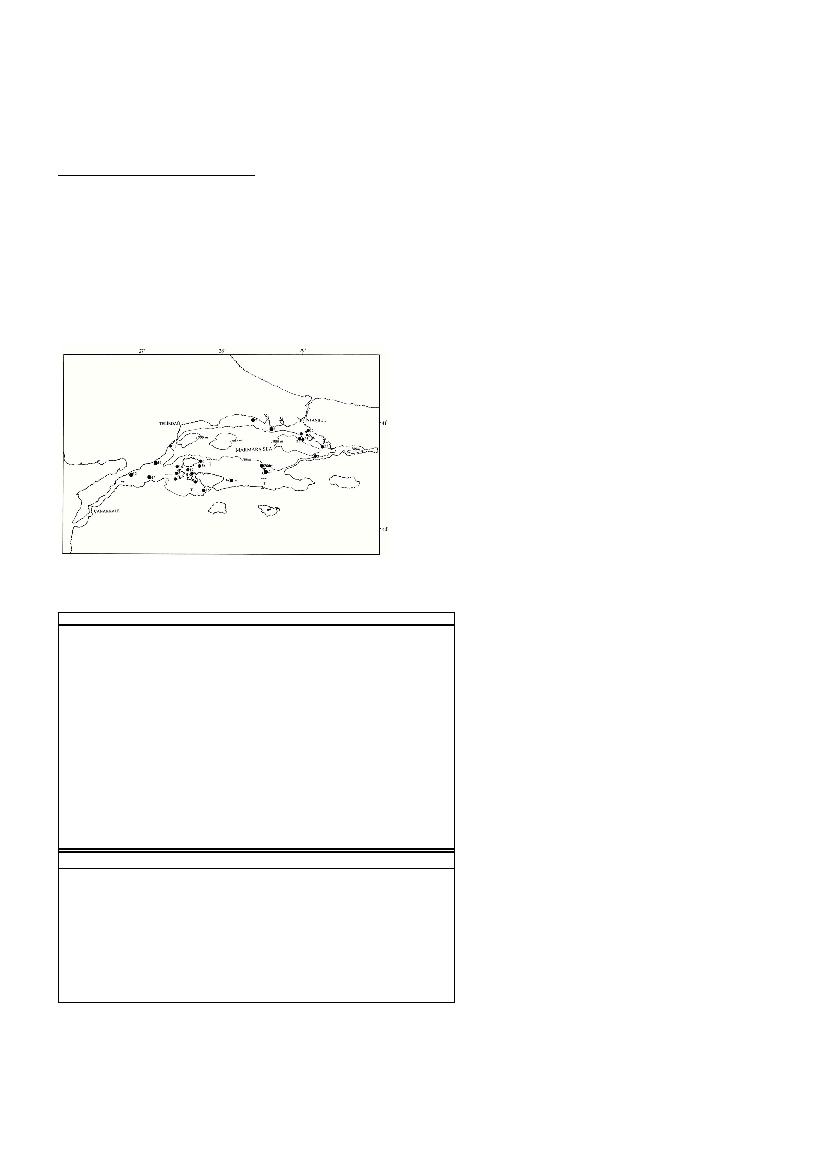Rapp. Comm. int. Mer Médit., 36,2001
421
Although, there are many studies on marine sponges of the
Mediterranean Sea, there is little studies in the Marmara Sea. This paper
presents results from the research on the sponge fauna of the Marmara Sea.
Material and method
The samples were collected by S
CUBA
diving, trawling, beam-trawling,
dredging and by using grab by research cruise R/V Yunusfrom 25 sam-
pling stations. Maximum depth was 52 m. for diving and 65 m for trawl-
ing (Map 1.). All sampling stations were situated in the upper infralittoral
zone. All samples were fixed by formaldehide solution (4%). Following
fixation spicules were isolated by Rützler’s standart method and observed
by using a binocular microscope. The identification of species was deter-
minate at The Station Marine d’Endoume-Marseille.
Results and discussion
19 taxons were reported from the Marmara Sea littoral zone in this
study. - see Table.1. Four of these taxons are new records for the Turkish
sponge fauna; descriptive characters of these species is as follows.
Halichondriidae- Ciocalypta penicillus Bowerbank, 1864
The samples were 8- 9 cm. length, typically palmate. The color is yel-
low.The spicules are, 200-400 µm. length and, 3-13 µm. thick fusiform
oxea.
Hymeniacidonidae- Dictyonella plicata (Schmidt, 1862)
The samples were an encrusting cover on a hard subtratum mostly on
the bivalves. The color is orange. The spicules 2000-2300 µm. length and,
22 µm. thick style.
Microcionidae- Microciona strepsitoxa Hope, 1889
The samples are an easily removable thin cover on a hard substarum.
The color is red, The spicules from 350-700 µm. to 70-200 µm. length and,
from 5-7 µm. to 4-6 µm. thick acanthostyle; 15--500 µm. length, 2-3 µm.
thick subtylostyle; 11-15 µm. palmate isochela and 200-400 µm., 91-140
µm. curved toxa.
Petrosiidae-Petrosia pulitzeri Pansini, 1996
The samples looks likes P. ficiformismorphologically. Most marked dif-
ference is that the color of the P. pulitzeriyellowish-white. Usually lives in
the underwater caves. The spicules from 200-240 mm.to 70-90 mm. length
and, 15-25 mm. thick. Strongyles; 300 mm. length and; 25 mm. thick
oxeas and, 70-200 mm. length, 10 mm. thick small oxeas.
Petrosia pulitzeriis reported in the Marmara Sea for the Turkish sponge
fauna for the first time. This taxon was mentioned as a new species by
Pansini (1). Besides, Microciona strepsitoxawas reported as a new record
from stations 2., 3., 5. and 12; Ciocalypta penicillus from satations 6. and
25.; and Dictyonella plicatafrom station 6.
Besides this, Ficulina ficuswas found at stations 6., 8., 14., 16., 17., 21.
and, Imrali Island. This species was reported by Topaloglu (2) as
a new record for the Turkish sponge fauna. 12 sponge species
were reported from the north of the Marmara Sea by Demir (3).
The results of this study confirm 19 species from the whole
Marmara Sea.
Most of the taxon were collected from stations 6 and 18 which
were a natural reef with depths of 2 to 60 meters. This sampling
point was relatively protected from negative antropogenic effect.
On the other hand, species of Mediterranean origin were found
deeper than 20 meters of the reef. This situation can explained
by oceanographic conditions of the Marmara Sea. The lower
layer of the Marmara Sea is consisted of Mediterranean Sea
originated waters (4). `
Acknowledgments
I wish to thanks of Dr. Bayram Öztürk for to supervising of the
study; to Dr.Jean Vacelet for the cooperation in the identification of
samples, Dr Ayhan Dede for assistance of SCUBA diving;
personnel of R/V Yunusfor cooperations of survey and thanks to
Med.Dr. Cumhur Erenel for assistance with the English of this text.
References
1) Pansini, M., 1996. Petrosia pulitzerin.sp. (Porifera,
Demospongia) from Mediterranean caves. Ital. J. Zool.63:169-172.
2) Topaloglu, B. 2000. A new record for the TurkIsh sponge
fauna;Ficulina ficus(Linnaeus, 1767). Symposium of the Marmara
Sea 2000; 11-12 November 2000, Istanbul p:485-492. (in Turkish).
3) Demir, M., 1952-1954. Bogaz veAdalar Sahillerinin Omurgasiz
Dip Hayvanlar. Istanbul Üniversitesi, Fen Fakültesi, Hibrobiyoloji
Arastirma Enstitüsü Yayinlari. No:3. s. 12-29.
4) Besiktepe, S., Özsoy, E., Latif, M.A. and Oguz, T., 2000.
Hydrogarphy and sirculation of the Marmara Sea. Symposium of
Marmara Sea 2000. 11-22 November. Istanbul. Turkish Marine
Research Foundation Publications. No:5 (Eds Öztürk, B., Kadioglu,
M., Öztürk, H.) ISBN 975-97132-1-7. pp. 314-326
SPONGE FAUNA IN THE LITTORAL ZONE OF THE MARMARA SEA
Bülent Topaloglu
Istanbul University, Fisheries Faculty and Turkish Marine Research Foundation, Turkey
Abstract
In this study, the samples were collected from 28 stations at depth of 0-65 meters both S
CUBA
diving and using dredge, grap, and beam
trawl. This is first systematical study on sponge fauna in the the Marmara Sea. As a result 19 species were found from the Marmara Sea
littoral zone Four of these taxons are new records for the Turkish sponge fauna (C. penicillus, D. plicata, M. strepsitoxa and P. pulitzeri).
KeyWords : Porifera, Sea of Marmara.
Station Number12345E
r
d
e
k6789101112K
.
K
ö
y13
Geodia cydonium
+
Tethya aurantium
+++
+++++
+
Cliona celata
+
Suberites carnosus
+
Ficulina ficus
+++
Aaptos aaptos
++
Acanthella acuta
++
Axinella cannabina
++
Axinella damicornis
+
Axinella polypoides
+
Agelas oroides
+
Ciocalypta penicillus
+
Dictyonella plicata
+
Microciona strepsitoxa
++++
+
Haliclona mediterranea
++++
+
Petrosia pulitzeri
+
Spongia officinalis
++ (S.sp.)
Station Number1415161718M
a
r.
I
s
l192021I
m
r.
I
s
l
.22232425
Tethya aurantium
+++++
+
Cliona celata
+
+++
Suberites domuncula
+
++
Ficulina ficus
++++
++
Aaptos aaptos
+
Axinella cannabina
+
Axinella damicornis
+
Axinella polypoides
+
Ciocalypta penicillus
+
Haliclona mediterranea
++++++
Petrosia ficiformis
+
Table 1. Sponge species in the sampling stations
Map 1. Sampling stations in the Marmara Sea (T : trawl; D : dredge; o :
Scuba diving)

